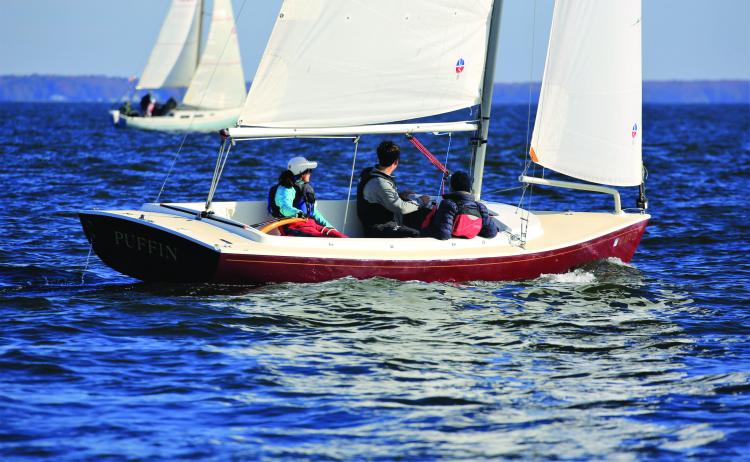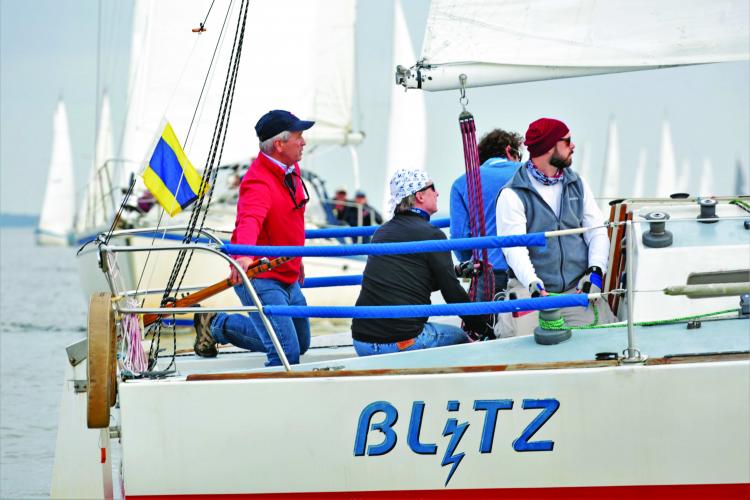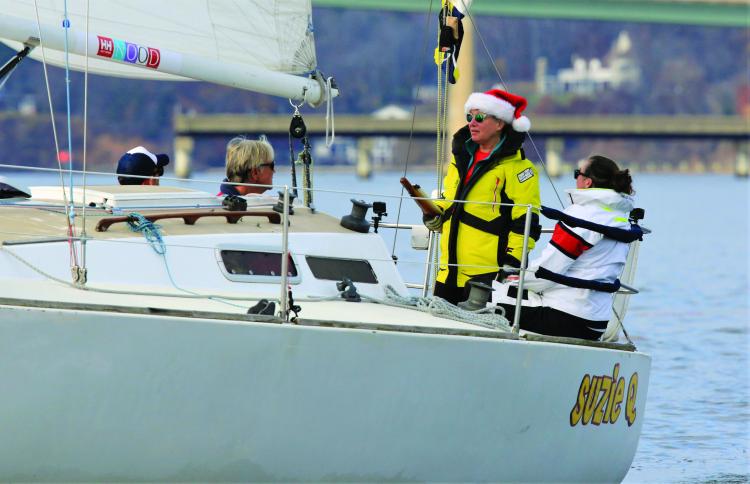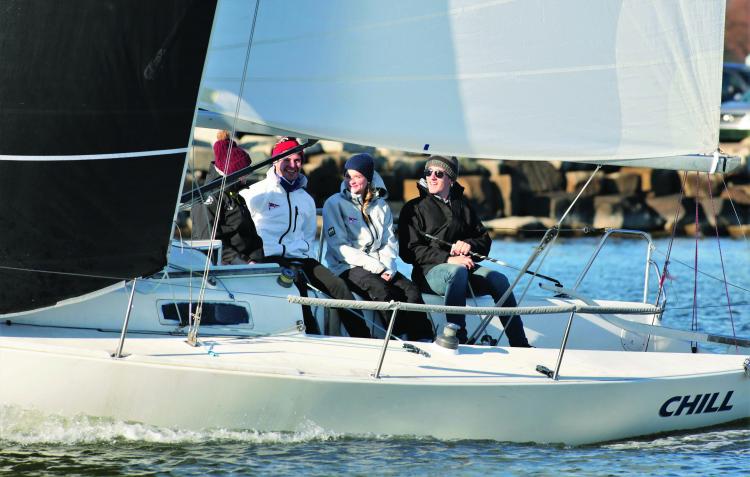Outside the Comfort Zone: Why We Frostbite Race as Sailors
To someone who prefers the couch to the cockpit when it’s wintry outside, the only question that makes sense to ask those who race sailboats or “frostbite race” is: “Why do you do it?” Yet, when you ask active frostbiters that question, their answers tend to make so much sense and exude so much enthusiasm that it makes you want to get up off the couch, gear up, and give it a try.
Harbor 20 sailor Bell Carty has been frostbite racing in the Annapolis Yacht Club (AYC) series since the early 90s. She says, “The appeal of frostbiting is to be on the water. It’s a little outside of the comfort zone, but still fun! Bundling up can be fun—it’s cold but not too bad.”
McGinnis races his 1979 J/30 Blitz, also in Annapolis, and has done so for the past decade. “First and foremost, I appreciate and enjoy the relaxed atmosphere,” he says. “We are all out there to have fun and to try to improve on some aspect of sailing that we can carry over into the next season. I think all of us understand that ‘it’s just frostbite.’ Not that we aren’t competitive! I mean, we are sailors… of course, we are competitive!
“As a skipper, I really like the two-race format. It gives me an opportunity to really focus on positioning the boat during the start sequence. If I make a mistake, I can get right back on the start line for the second race and try it again.”
Frist is a little bit newer to the game, having started her frostbite race career aboard her J/30 Suzie Q three or four years ago. She says, “I enjoy frostbiting because my crew and I can focus on fine tuning our basic skills (i.e. timing starts, trimming, and tactics) without having to deal with the spinnaker. We also don’t need as many crew to race in frostbites, so finding crew is a little easier.”
There’s no bad weather, only bad gear
Frostbite sailors learn quickly what works best for them in terms of warmth and dryness. Carty wears her “old Musto and Helly Hansen foulies over Patagonia puff jacket and fuzzy pants. Now I wear an Army hat to support my cadet! Always a warm hat! Always gloves. Any kind that keeps your hands warm and fit properly.”
McGinnis says, “With the unseasonably warm temperatures we’ve had lately, this is a hard question to answer! Heck, some days I’ve contemplated sailing in shorts! When the temperatures really drop, I have a pair of Harken neoprene gloves that I really like. I also wear some winter socks by Fox River that I got issued back when I was in the Army. They’re made from some kind of heavyweight wicking material that really does a great job of keeping your feet warm and dry.”
“I love my Dubarry Boots and my fleece ear flap cap from Duluth Trading Company,” says Frist. “I feel like I can withstand the cold temps no matter how low they go by keeping my feet and head warm! Other mainstays are fleece lined leggings, layers of tops, a warm foul weather jacket, full-fingered racing gloves, and good sunglasses.”
There are tough days…
About 10 years ago when he first started racing, McGinnis says, “I had a J/24 named SWAG. My crew and I decided to race the Hangover Bowl… Up to that point, my only experience racing was with the standard windward/leeward format during weekend regattas and Thursday nights with J/World. I had absolutely no experience finding my way around government marks. This particular Hangover Bowl, the temps were in the 20s or 30s, and the wind was howling and just brutally cold. Between the strong gusts, the cold air, and not having the first clue where I was on the racecourse, let’s just say our overall performance was less than impressive. We had fun and we learned a lot… but I was happy to get off the water!”
Frist says, “Every frostbite race has the stress of trying to make sure we can see all traffic, especially the tiny boats crossing our path. This is a challenge because we are not allowed to leave the cockpit.”
Carty shares a lighthearted cold-day memory: “When we were rigging the boat, we were scraping ice and snow off of it and launched with snow still in the cockpit. We had snowball fights and were laughing around the racecourse. The tough part that day was keeping your hands warm!”
Making amazing memories
One memorable day for McGinnis came early in the season. After making a smart decision to start closer to the seawall than the pin, he managed to stay in the pressure, put a substantial distance between his boat and the rest of the fleet, and score the bullet. “We had not had a good season up to that point, so the bullet was a much-needed morale boost, not just for me but for the crew,” he says. It changed the way his crew now approached the wind when it was coming down the Severn.
“The other thing that was reinforced that day is the value of having a quiet boat. As we were heading back from that win, my main trimmer leaned over and said, ‘Did you notice nobody was yelling?’ He was right. Everyone on the boat knew what they were doing. We were all focused on one thing: making the boat move fast… Since then, I’ve done my utmost to recreate that environment every time we get on the racecourse. I’ve got a great crew. All I need to do is trust that they know what they are doing, get out of their way, let them do their job, and just drive the boat!”
Advice for would-be frostbite racers
What would these sailors recommend to anyone interested in frostbite racing in the future?
McGinnis says, “I think the best way to get into frostbite racing is to get into Wednesday or Thursday night racing, and the best way to find a boat for Wednesday night or Thursday night racing is to list yourself on the SpinSheet Crew Finder list (spinsheet.com) or attend the SpinSheet Crew Party (in spring). I say this because there simply isn’t much room for extra crew during frostbite races (since) we aren’t using spinnakers and have to keep everyone inside the cockpit.” The idea is that once frostbite season rolls in, you’ll already be an active part of a team.
Frist says, “If someone wanted to get into frostbites as crew, dress warmly, and bring fun boat snacks! As a skipper, don’t use your best racing sails!”
Carty adds, “If you are interested, find someone doing it that can help you out. Go down to the dock, talk to people, and ask!” ~M.W.








